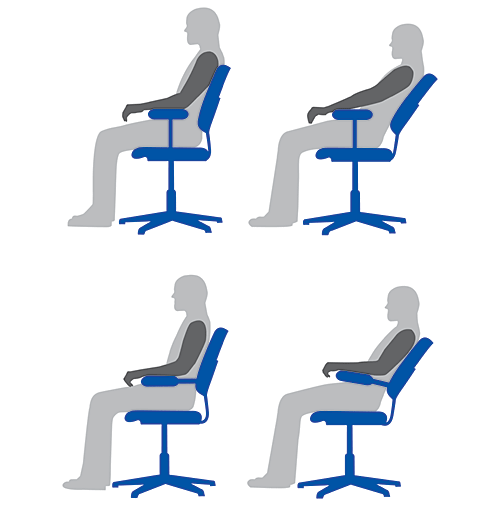The complex challenge of choosing an office chair involves the critical issues of optimal employee health and performance, as well as environmental sustainability.
Creating a Global Standard
for the Office Chair |
In need of a global standard for the many thousands of task chairs used by employees around the world, Kim Sutherland, ergonomics program manager in the health and safety department of a high-tech Fortune 500 corporation, undertook an extensive process. "We identified all the countries we were in and gathered anthropometric data for each to make sure we were recognizing how tall and how small people might be." Using BIFMA G1-2002, as well as other relevant country specific guidelines, she established a lengthy list of international ergonomic criteria for chairs to adjust from the fifth percentile female to the 95th percentile male. These were: seat height, depth and width; seat pan angle; backrest height and width; lumbar support height; the angle between the seat and the back; armrest height and length; the inside distance between the armrests; and ease of operation so that all adjustments could be made with the end user sitting in the chair.
After an RFP yielded nine chairs, Sutherland, who is an engineer and physical therapist, elicited user experience by asking employees to evaluate the chairs according to a checklist modeled after the Cornell Ergonomic Seating Evaluation Form (www.ergo.human.cornell.edu). The checklist included questions about the ability to easily adjust the chair, ability
to fit the particular individual, comfort and perceived aesthetics. The team also analyzed each chair according to procurement criteria such
as price, warranty and service in the different countries where the
company has offices.
"We first thought we wanted one chair to meet uses around the globe, but there are sites where aesthetics demand one chair over another. So
we created a list of chairs that qualified for our criteria and ranked them. Interestingly, the chair that was top in ergonomic, procurement and end user choice happened to be the same chair."
Established some 18 months ago, the chair global standard has been
very successful, reports Sutherland. "People are extremely happy. The chair selection process in all countries has become much easier. We do not get complaints and in many cases receive praise. The ability to make a chair fit has been much easier because end users can do it themselves. There are far fewer requests for interactions with the ergonomics department."
|
|
Manufacturers have responded by providing a multitude of mechanisms for adjusting chair dimensions and other components. New models have weight recognition technology that dynamically adjusts backrest resistance to perfectly support each user.
Some adjustments, such as chair height, are obviously the responsibility of the user. But others are best accomplished through automatic mechanisms in order to avoid injury and restriction of movement. Locks and manual recline tension devices fall into this category. Superior ergonomic chairs on the market have automatic and dynamic recline adjustments that accommodate both the 100-pound woman and the 250-pound man, thus allowing spontaneous movement and continuous support for users when they recline.
Another example of the advantages of dynamic adjustability over fixed or manual adjustability is the headrest. Fixed or manually adjustable headrests are either in the way when they are not needed or not in place when they are. Headrests that dynamically adjust to provide proper support during recline are preferred.
Knowledge of the different features of chair construction is also important in understanding the implications of adjustability. Armrests that are connected to the seat, for instance, may cause shoulder extension during recline, while armrests connected to the backrest will move with the body when the user reclines and provide continuous support.
 |
Armrests connected to the backrest move with the user for better support during recline than armrests connected to the seat. |
|
Sustainability and LEED Points
Most of the major chair manufacturers are incorporating principles of sustainability into their products and manufacturing processes. Using life cycle concepts, they are analyzing each production step, material origin and end use, transportation and packaging.
Materials and Components
Environmentally preferred products weigh less and have fewer parts (one manufacturer's task chair weighs 27 pounds and contains 129 parts; another manufacturer's chair weighs 78 pounds and has more than twice as many parts), thus requiring fewer production processes and less material to source, manufacture, transport and dispose of or recycle.










